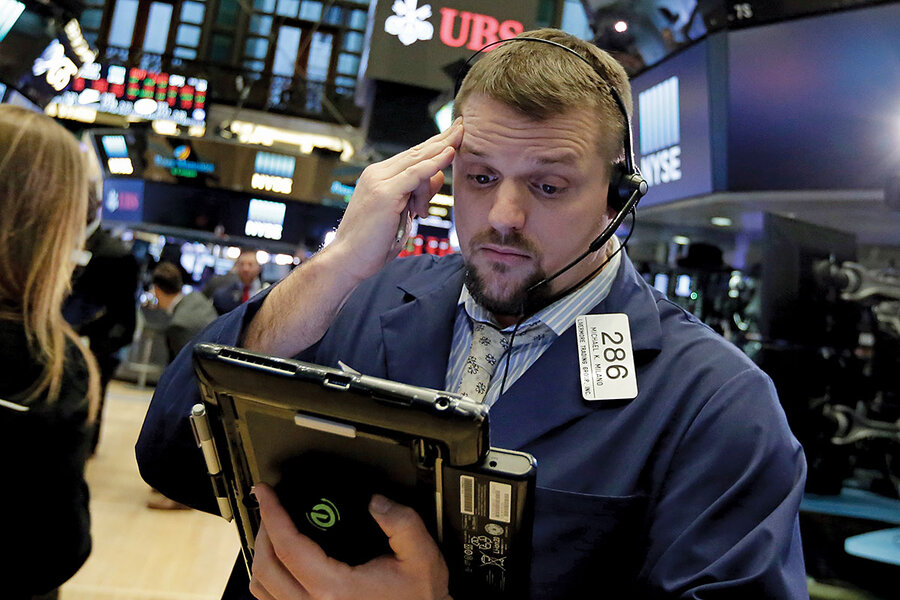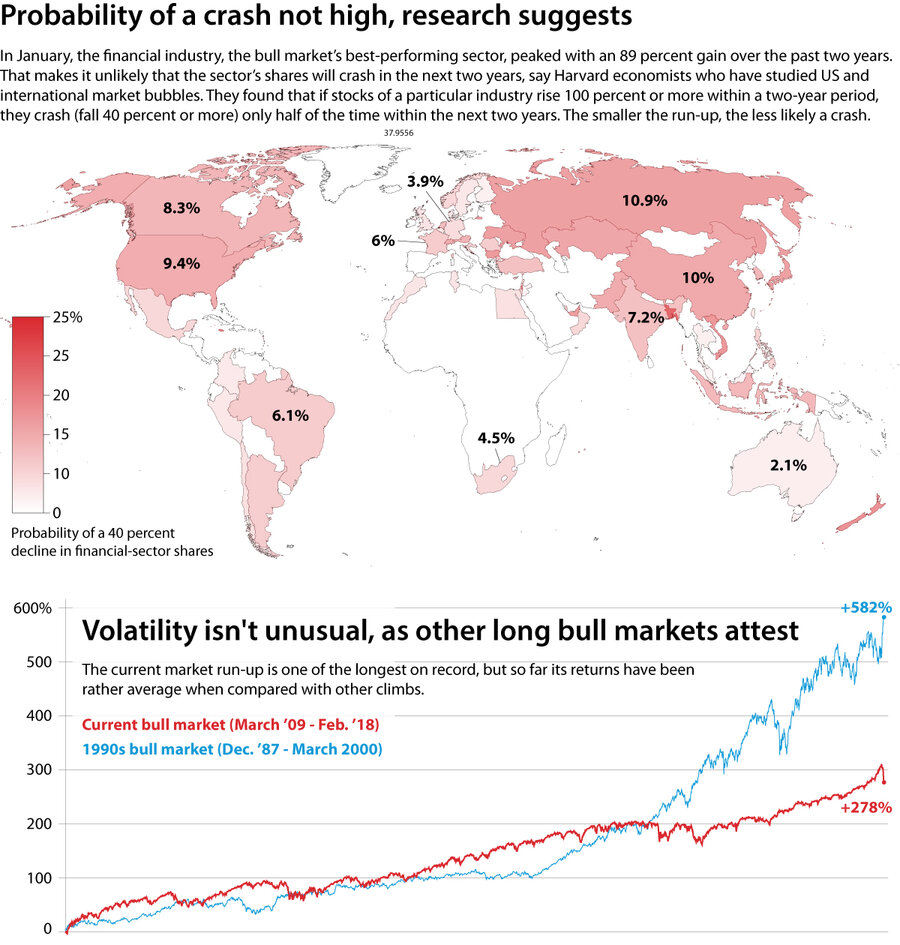Global markets see-saw. But return of volatility shouldn’t be surprising.
Loading...
Just when things were looking up, the world’s investors got scared again.
In the course of just two trading days, the US stock market lost 5.5 percent of its value – and most of the rest of the world followed: Japan (-7.2 percent), France (-3.8 percent), and Germany (-2.3 percent).
But the sky isn’t falling, at least, not yet, if history is any guide. Monday’s record fall in terms of points – 1,175 points on the Dow Jones Industrial Average – was far less damaging in percentage terms than the crash of 1987 or the market plunges in the run-up to the Great Recession. And on Tuesday the Dow regained almost half its prior-day loss.
Instead, world markets look headed toward a period of greater volatility and, quite possibly, what's called a correction. Japan’s Nikkei is already there, with shares declining just over 10 percent since their highs last month. The Standard and Poor’s 500, which is a broader market index than the Dow, was down nearly 8 percent after Monday’s rout.
Corrections are normal occurrences, happening on average about once a year. (A bear market, where prices fall at least 20 percent, is more rare.) The return of volatility, however, is more telling.
The past two days have jolted US investors out of a remarkable complacency – where stocks were expected to keep going up indefinitely – to a new appreciation of the rising risks to the world economy after one of history’s longest bull markets. Fear, in other words, is now competing with greed.
The CBOE Volatility Index, known as the VIX or “fear index” for US stock investors, fell to record lows last year. But on Monday, it notched its biggest ever one-day rise, more than doubling to 37, at the market’s close. That’s the highest it’s been in 2-½ years, but hardly a record.
And so far, it’s not clear that hordes of panicked investors are calling their brokers or financial planners, telling them to sell their stocks.
“We’ve had nothing,” says Rick Miller, founder of Sensible Financial Planning in suburban Boston. “But just because people aren’t calling doesn’t mean that they’re not nervous.”
Reasons behind the sell-off
What are investors nervous about?
Inflation looms large. US stock markets began falling Friday after the Bureau of Labor Statistics reported that average hourly earnings for private-sector workers saw their biggest wage gain in more than eight years. Big wage gains can fuel inflation, which central banks fight by raising interest rates. Higher interest rates, in turn, can make bonds more attractive to investors and stocks less attractive.
But wages only rose 2.9 percent year over year, much less than the wage increases before the Great Recession of 2007 to 2009.
“Markets have been addicted to low interest rates and global central banks pumping money into the financial system,” said Greg McBride, chief financial analyst at Bankrate.com, in a note to reporters. “As economies around the world are improving, this means higher interest rates and less stimulus from central banks. That’s why investors are throwing a hissy-fit. Not because anything is wrong.”
Another worry: China’s expanding private debt and soaring real estate prices. Analysts have warned for months that the bursting of those twin bubbles could trigger a worldwide crash. But Beijing is working hard to tamp down private borrowing, and the Shanghai Composite index is already down more than 25 percent from its 2015 highs.
Then there’s the run-up in stocks itself. In bourses around the world, share prices have set record after record. In the US, the second-longest bull market has led to a 32 reading on the Cyclically Adjusted Price Earnings ratio, a special stock price-to-earnings measure developed by Yale economist and Nobel laureate Robert Shiller and Harvard economist John Campbell. Only twice before has the index surpassed 30: right before the 1929 stock market crash (32.6) and the dot-com crash of 1999 (44.2)
So are stocks in a bubble that means an inevitable crash? Stock bubbles are hard for economists to define. But the short answer appears to be: probably not.
The economy remains strong and is adding new jobs. Rising wages, which spooked investors momentarily, remain good news for consumer spending going forward. Although adjustments from the just-passed tax reform have muddled the picture a bit, quarterly earnings released by companies so far have been generally positive. So there are good reasons why stocks can go up without pushing into bubble territory.
New data on bubbles and crashes
Last year, three Harvard economists published a paper looking at stock bubbles. They found that if stocks in a particular sector rose 50 percent or more within a two-year period, the odds that they would crash (fall 40 percent or more) within the next two years were only about 1 in 5. If they rose 100 percent, the odds rose to about 1 in 2. If stocks climbed 150 percent or more, the odds of a crash were 4 in 5.
So far, the best performing sector of this bull market has been the financial industry, which by late January’s peak had risen 89 percent in two years. And unlike either 1929 or 1999, “the stock market gains have been pretty even across industries,” Harvard economist Robin Greenwood, the lead researcher on the paper, writes in an email.
Thus, their data suggests that a crash of 40 percent is more unlikely than likely in major markets across the world, with China at the end of 2017 carrying some of the biggest odds with 26 percent. The United States was at 11 percent. (See chart accompanying this article.)
To see what a real bubble and crash look like, look at Bitcoin. Between April and December of last year, it rose an amazing 1,400 percent. Although Bitcoin is not a stock, the trends from the Harvard research suggest it was ripe for a huge fall. Sure enough, the cryptocurrency has now lost more than 60 percent from its December highs.
Timing any crash remains tricky. According to the Harvard researchers, it took on average six months before a sector identified as a bubble market actually peaked, and the average gain during that period was 30 percent.
Some other analysts say US stocks look pricey but not in bubble terrain. In a December market outlook, Vanguard strategist Joseph Davis predicted “a bit more volatility and … more muted equity returns” in 2018.
So what does volatility, of the kind now being experienced in markets around the world, signal for investors?
In his analysis, Mr. Davis said that, even with a more restrained outlook for stocks, average investors generally will be well served by staying the course and “maintaining a balanced and globally diversified portfolio.”
“What volatility tells us,” says Mr. Miller of Sensible Financial, “is that stocks are risky!”







